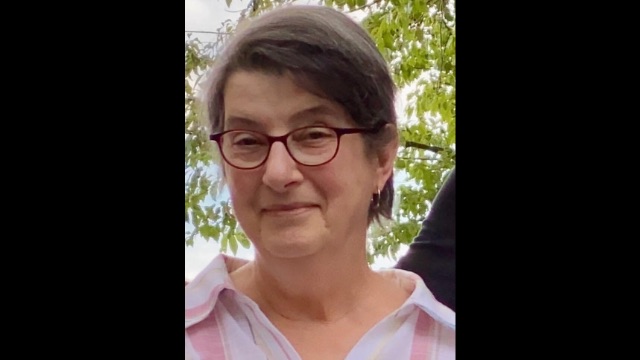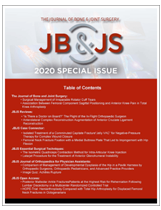


“Fight for the things that you care about, but do it in a way that will lead others to join you.”
Ruth Bader Ginsburg
Mady Tissenbaum’s work over the course of her >40-year tenure is largely responsible for making JBJS what it is today: the premier orthopaedic journal in the world. She has been described by colleagues as forward-thinking, intellectually curious, prescient, analytical, unflappable, innovative, quietly confident, calmly assertive, diplomatic, knowledgeable, adaptable, and patient. Her impact cannot be overstated and is reflected in every facet of the organization. Simply put, Mady was instrumental in transforming JBJS from a small academic journal into a thriving modern business with a suite of gold-standard journals and educational offerings.
Mady was hired at JBJS in 1973, on the basis of her “experience, plus youthful eagerness,” for a copyediting position with no formal title. Her trajectory through JBJS is a testament to her skills, confidence, and determination. In 1978, just 5 years into her tenure, she took the initiative to write a letter to her supervisor in which she spelled out her conditions for continuing working at JBJS, which included many perks that current JBJS employees take for granted: privacy (“a divider, or better yet, a wall”), a dedicated office phone, a formal vacation policy, yearly performance reviews, and a formal job title. Her enthusiasm for broadening her knowledge was already on display as she requested “rotation through departments, as time allows, so I can learn the systems used” and “tutorial inclusion on business aspects of The Journal.” Mady has since reflected that she “was given a great deal of freedom at JBJS. It was a very old-fashioned place when I came, and thus offered massive opportunities for positive change…the changes and innovations I proposed were very rarely hindered by bureaucratic obstacles or entrenched habits and traditions.”
One of the areas in which Mady was most influential was in her fearless embrace of new technology. Although the organization was still using typewriters when she was hired, Mady was among the first employees to learn how to use a personal computer and subsequently started and managed the first internal network, acted as IT director, established the desktop publishing department, conceptualized and researched SGML conversion of JBJS content, built the first manuscript database, built the first JBJS website, managed production of the first CD-ROMs, championed the addition of electronic publications (Essential Surgical Techniques and JBJS Case Connector), and started the complex taxonomy of orthopaedic terms that is still in use today. Mady was prescient when she noted in 2010 that “Ever more sources of information will bombard our customers, who will find it increasingly difficult to distinguish between reliable information and bad data. Brands will become both more important and less reliable as they seek to be all things to all people. More small players will be swallowed by large ones. Gimmicky learning tools will proliferate, as will portable tools of all sorts, most of them useless and quickly abandoned. Another 10 or 15 years of internet-based Gold Rush/Wild West high energy, rapid innovation, lack of standards, and uncertainty lie ahead. Then it will settle down, and something we haven’t imagined yet will be the next frontier.”
Whether taking apart a computer, learning coding languages, building macros in Excel, or being the first female employee to attend JBJS board meetings, Mady continually looked for ways to grow both personally and professionally. In 1998, she was promoted to Managing Editor, a title that was soon changed to General Manager. In this role, with the support of various Editors-in-Chief, Mady consistently embraced change while aggressively seeking innovative solutions to long-standing problems as well as to new challenges, worked intensively with every department supervisor to accomplish the goals of the Editor and Board, relentlessly expanded her knowledge of publishing and information and web technology, and originated and carried out numerous ideas to streamline and modernize JBJS procedures. That role touched essentially every part of the organization: IT, HR, Marketing, Advertising, pension and benefits, invoice and payroll, printing and paper choices, web design, and permissions for reproductions. It would probably be more efficient to list what she didn’t do. Her research and broad knowledge continually resulted in savings of money, time, and effort, and allowed her to see where things could be changed, tweaked, tightened, or eliminated to make JBJS run more smoothly and efficiently.
Never one to rest on her laurels, Mady also consistently sought out the latest information in the field by attending the conferences of scholarly publishing organizations such as CSE, SSP (from which she received the Distinguished Service Award in 2015), and COPE; researching industry standards; getting her MBA (while working full-time); and expanding her (and, by extension, the company’s) professional network. As Mady herself noted, “I never went to a meeting where I didn’t learn something really useful. I had no peers at JBJS for decades; I found them at meetings. That’s where I learned the norms of medical publishing, found out how a computer network works, gained information about software programs, learned to create and index CDs, and discovered the existence of professional associations and societies that JBJS had never heard of, for such matters as ethics in medical publishing (COPE) and facilitation of accuracy in reference citations (CrossRef). Everything I learned came back to JBJS in multiples as I was educated and stimulated by those professional contacts. It created my network, and my network was used for the benefit of JBJS.”
When training new employees, Mady always provided constructive feedback and set the high standards for accuracy that helped JBJS build its reputation for producing scholarly content of the highest quality. Despite her full plate, Mady made it a point to mentor others in the JBJS office, especially female employees. Associate Vice President of Publishing Amy Bordiuk has praised her for having “the courage, drive, and tenacity to build the career for which we are celebrating her today while, at the same time, being completely supportive of other women’s choices.” When Amy was a new mother, Mady encouraged and enabled her to work part time from home instead of leaving JBJS entirely. And when Amy returned to the office, “it was Mady who trained me, encouraged me, and gave me more and more responsibility all the while assuring me that it was OK to leave at 4:00 on the dot so I could get home to my daughter and to run out in the middle of the day for school plays and parent-teacher conferences.” As a leader, Mady showed an all-too-rare level of support for her female employees that helped them to deliver excellence in the office and beyond. Associate Vice President of Sales and Marketing Bev Ouannass says that “Mady paved the way for women at JBJS. At a time when women did not have a seat at the table, Mady pushed the boundaries. She recognized my drive and ambition, which she continually encouraged. In fact, she inspired me to attend business school, all while raising three children and working full-time at JBJS. It’s these qualities that have left an indelible mark on my life.”
At Mady’s retirement party in 2015, Betsy Bellar, Chief Education Officer, noted that “all I really need to know about STM publishing, I learned in [Mady’s] office…. She has been the consistent presence in the organization focused on mission, publishing the best research and improving patient outcomes. She always takes the high road.”
Mady’s influence still resonates strongly to the present day, serving as a catalyst for the entire organization to continually fulfill its motto of “Delivering Excellence.” As she noted in an interview in 2010, “My interests lie in the interfaces between presentation of information, language, learning, and ease of use. How can we help our audience absorb new information rapidly in a manner adapted to their varied learning styles, help them formulate the questions whose answers will advance the field, and assist in their research? What new opportunities have we not yet discovered in the move from print on a page to presenting text, video, and speech via the internet? The struggle, perhaps for all of us, is to ensure that the quotidian doesn’t block imagination.”

Sign up to receive your free JBJS 2020 Special Issue—a compilation of the most-read articles. You get twelve articles across six JBJS publications in this special issue.